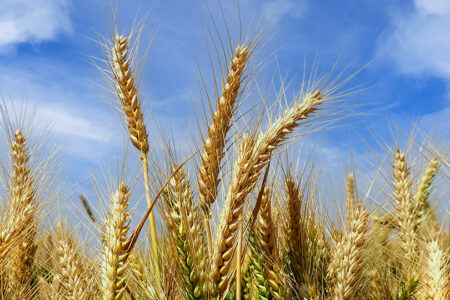Behold the Lamb!
Passover, Unleavened Bread, and Firstfruits—and what they tell us about the Messiah
Many non-Jews think Hanukkah is every Jewish person’s favorite holiday. But they would be wrong. Hanukkah is not the Jewish equivalent of Christmas, and many Jewish people actually prefer Passover. Far more rituals, traditions, and biblical history accompany Passover, making it one of the best-loved holidays on the Jewish calendar.
The modern celebration, which incorporates the Feasts of Unleavened Bread and Firstfruits, is an eight-day observance (seven in Israel) that begins at sundown with a Seder—a worship service held at the dinner table, followed by a wonderful meal that is conspicuously bereft of all products containing leaven. For the duration of the holiday, observant Jews eat nothing that has been allowed to rise. It is the holiday for matzoh, the “bread of affliction” (Dt. 16:3).
Passover also is when parents teach their children the importance of remembering how God delivered the Jewish people from slavery in Egypt by inflicting 10 plagues on the Egyptians, including death of the firstborn son. And they retell the story of God parting the Red Sea so the children of Israel could cross on dry land.
But Passover, Unleavened Bread, and Firstfruits involve more than the Exodus from Egypt. The ancient rabbis viewed them in light of the coming Messiah and His Kingdom (Talmud Sanhedrin 99a). These three observances are uniquely braided together and foreshadow the person and redemptive ministry of the Messiah, who historically and prophetically is identified as Jesus.
Passover
God gave specific instructions for Passover when Israel was in bondage (Ex. 12). The elements involved were lamb, unleavened bread, and bitter herbs (v. 8).
Each household was to select a male lamb of the first year that was without blemish (v. 5). The lamb was kept four days and then was slain (vv. 3–6). Some of its blood was applied to the two doorposts and lintel of the homes for a specific purpose (v. 7).
When God saw the blood, He passed over those houses and did not smite the firstborn males. Prophetically, the lamb foreshadowed the Messiah’s First Advent as a sacrificial lamb. Wrote the prophet Isaiah, “He was oppressed and He was afflicted, yet He opened not His mouth; He was led as a lamb to the slaughter, and as a sheep before its shearers is silent, so He opened not His mouth” (Isa. 53:7).
During Temple times, the priests selected the lambs. When John the baptizer, a Levitical priest, saw Jesus approach the banks of the Jordan River, he declared, “Behold! The Lamb of God who takes away the sin of the world!” (Jn. 1:29).
As God’s Lamb, Jesus offered His body and blood as a perfect sacrifice, securing our redemption: “Knowing that you were not redeemed with corruptible things, like silver or gold, from your aimless conduct received by tradition from your fathers, but with the precious blood of Christ, as of a lamb without blemish and without spot” (1 Pet. 1:18–19).
Bitter herbs reminded the Israelites of the bitterness of slavery. Prophetically, they pictured the Messiah as a suffering lamb (Isa. 53:7). The priests also slaughtered the Passover lambs. Theologically, no man took Jesus’ life. He Himself said, “No one takes it from Me, but I lay it down of Myself. I have power to lay it down, and I have power to take it again” (Jn. 10:18).
Jesus willingly took on the bitter ordeal to bear our sins: “Behold,” He said, “we are going up to Jerusalem, and the Son of Man will be betrayed to the chief priests and to the scribes; and they will condemn Him to death, and deliver Him to the Gentiles to mock and to scourge and to crucify. And the third day He will rise again” (Mt. 20:18–19).
Feast of Unleavened Bread
Passover and the Feast of Unleavened Bread usually are considered one festival (Ex. 23:15). “Now the Feast of Unleavened Bread drew near, which is called Passover” (Lk. 22:1). However, they are distinct in significance.
Unleavened Bread begins on the evening of the Passover and continues for seven days. The Jewish people are to eat nothing with leaven. Bible scholar Dr. Thomas L. Constable noted God’s purpose:
The Old Testament often uses leaven as a symbol of sin. Leaven gradually permeates dough, and it affects every part of the dough. Here it not only reminded the Israelites, in later generations, that their ancestors fled Egypt in haste, before their dough could rise—it also reminded them that their lives should resemble the “unleavened bread” as redeemed people.1
Though Unleavened Bread memorializes the Israelites’ hasty departure from Egypt (Ex. 12:39; Dt. 16:3), prophetically it indicated Messiah would be a sinless sacrifice. As Isaiah declared, “All we like sheep have gone astray; we have turned, every one, to his own way; and the LORD has laid on Him the iniquity of us all” (Isa. 53:6).
Though sinless, the Messiah would suffer the affliction of bearing the sins of mankind:
Surely He has borne our griefs and carried our sorrows; yet we esteemed Him stricken, smitten by God, and afflicted. But He was wounded for our transgressions, He was bruised for our iniquities; the chastisement for our peace was upon Him, and by His stripes we are healed. Yet it pleased the LORD to bruise Him; He has put Him to grief. When You make His soul an offering for sin, He shall see His seed, He shall prolong His days, and the pleasure of the LORD shall prosper in His hand (vv. 4–5, 10).
The priests also inspected the lambs. All sin offerings had to be unblemished and perfect (Lev. 1—5). During Jesus’ last week on Earth, the religious authorities challenged Him with incriminating questions, trying to find fault in Him. The chief priests challenged His authority (Mt. 21:23). The Pharisees and Herodians questioned His allegiance (22:17). The Sadducees posed a hypothetical question concerning resurrection (vv. 23–28). Finally, an expert in religious law tempted Jesus by asking which commandment was the greatest (v. 36).
Through it all, Jesus was “unleavened”—no fault was found in Him (1 Pet. 1:19).
Firstfruits
The Feast of Firstfruits falls on the second day after Unleavened Bread (Lev. 23:10–12). Firstfruits in Hebrew is the word bikkurim, which actually means “promise to come.” It expresses trust in God’s present provision and looks by faith to a greater harvest to follow.
Jesus, the perfect, sinless Lamb of God, was slain on a cross; placed in a tomb; and rose from the dead on the third day, as prophesied (Ps. 16:10; Isa. 53:10; Mt. 17:22–23).
The apostle Paul explicitly stated that Jesus’ resurrection was the firstfruits of those to be raised from the dead:
But now Christ is risen from the dead, and has become the firstfruits of those who have fallen asleep. For since by man came death, by Man also came the resurrection of the dead. For as in Adam all die, even so in Christ all shall be made alive. But each one in his own order: Christ the firstfruits, afterward those who are Christ’s at His coming (1 Cor. 15:20–23).
The first three spring observances are distinct but distinctively interwoven. In them, God gave the Jewish people a beautiful picture of His grand, eternal plan to redeem all mankind through the Messiah of Israel.
ENDNOTE
-
-
- Dr. Thomas L. Constable, “Notes on Exodus,” 2021 ed., soniclight.com on planobiblechapel.org, (tinyurl.com/Constable-Notes).
-









I researched all seven Jewish feast days. I think the fourth feast is the most interesting but so little is known in the Christian world about Pentecost. We are still waiting on the fall feast to have their spiritual fulfillment.
if you read Leviticus chapter 23 verses 10 to 12 say the day after the sabbath which is the Jewish first day of the week recorded in Mathew,Mark ,Luke and John and the same Pentecost is always counted from the day after the sabbath for 50 days which is always the first day of the week Leviticus chapter 23 verses 15 to 17.